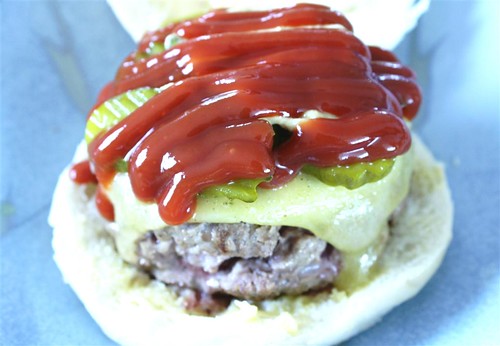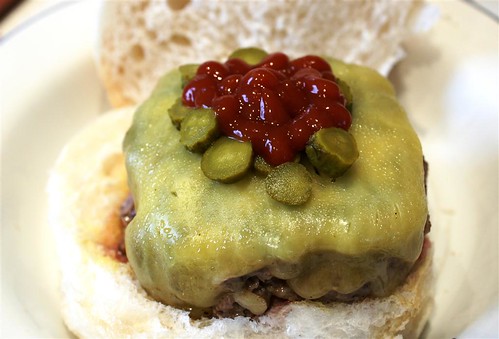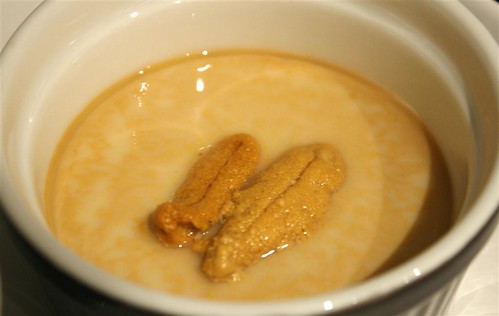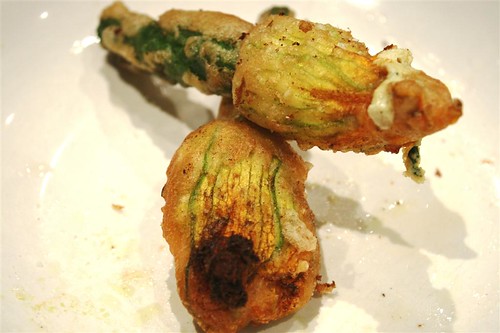My colleague AW at work passed me this recipe from his Ad-Hoc at home book. When I first read it ... I was like.. wtf ?!?! refrigerate in brine for 10hrs... slow cook in lard for 6 hours ... refrigerate in lard for 12 hours.. 1.5kg of lard !!!!!!!
So I went to my local supermarket and filled my shopping basket with 8x 250g blocks of lard (I brought more in case I needed it) and safely made my way back home with all my blocks of lard. And I picked up a 1kg piece of pork belly from my local butcher on the way back. The rest of the herb ingredients I got from my now flourishing herb garden.. :)
This was
the way to consume fat. Every single bite would just melt in your mouth. The way the fat and the meat would just melt into each other. It was pure pork goodness.
My house smelled of melting lard for the whole 2 days I spent making this. But upon tasting the first piece.. I didn't care anymore. It was well worth it. :)
recipe from Ad-Hoc at Home by Thomas Keller
Phase 1 - Preparing the Brine:- 1/4 cup plus 2 tablespoons honey
- 12 bay leaves
- 3 large rosemary sprigs
- 1/2 bunch thyme (about 10 sprigs)
- 1/2 bunch (about 10 stems) flat-leaf parsley
- 1/2 cup garlic cloves (crushed, skin left on)
- 2 tablespoons black peppercorns
- 1 cup kosher salt, preferably Diamond Crystal
- 8 cups water
Combine all the ingredients in a large pot, cover and bring to a boil. Boil for 1 minute, stirring to dissolve the salt. Remove from the heat and cool completely, then chill before using. The brine can be refrigerated for up to 3 days.
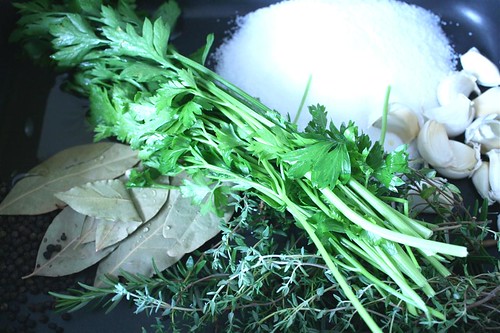 Ingredients for the Brine
Ingredients for the Brine- Pork Brine (Cold)
- 1kg slab pork belly with skin
- About 6 cups lard
- Canola Oil
- Gray salt or coarse sea salt
Pour the brine into a container large enough to hold the pork belly and add the pork, Refrigerate for 10 hours (no longer, or the pork may become too salty)
Remove the pork belly (discard the brine) and rinse under cold water. Pat dry with paper towels, or let air-dry.
Preheat the oven to 90C.
Choose an ovenproof pot, such as a 12-quart Dutch oven, that is only slightly larger than the pork belly and has a lid; the pot should be just large enough that the pork will be surrounded by the lard. Put the belly in the pot and cover with the lard; the lard should cover the pork by 1/2 to 3/4 inch.
Heat the pot over low heat until the lard registers 88C. Cover, transfer to the oven and cook until the pork is meltingly tender; this will probably take 5.5 to 6 hours, but start checking after 4 hours. As the belly cooks, it will lose fat and shrink; it is best to transfer the meat and fat to a smaller pot, always keeping the belly covered by fat. Remove the pot from the oven and let cool to room temperature.
The belly can simply be refrigerated in its fat, but we prefer to press it to compress the internal layers of connective tissue and force out the excess fat, resulting in a better texture and appearance. To press it, transfer it to a deep baking dish. Pour enough fat into the dish to just cover the belly. Cover with plastic wrap, top with a smaller baking dish and weight it down with a brick or large can. Refrigerate for at least 12 hours; reserve the extra fat.
Once it's been pressed, the pork belly can be refrigerated, covered by fat (add some of the reserved fat if necessary), for up to 1 week.
To serve, remove the pot from the refrigerator and let sit in a warm spot to soften the fat for 2 to 3 hours. Your want to soften the fat enough so you can scrape it from the belly while keeping the belly as cold as possible so it will be easier to slice.
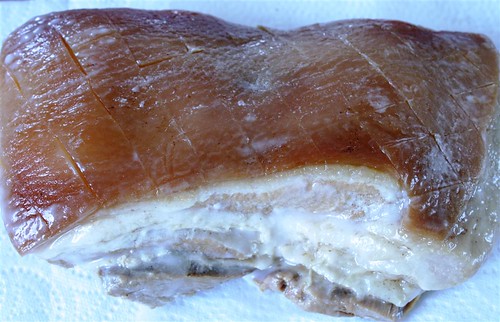 Shot of Pork after scoring the skin
Shot of Pork after scoring the skinRemove the pork belly from the fat, and wipe off any cooking fat that clings to the meat. Remove the skin and score the fat on the belly in a crosshatch pattern. The belly can be cut into any shape. Slice it or cut it into squares, and let sit at room temperature for 20 to 30 minutes before sauteing. (The fat can be reused to confit pork belly several more times as long as it does not taste too salty. Pour it into a pot and heat gently to liquefy, then strain through a find-mesh conical strainer into storage container. Refrigerate for up to 2 months or freeze for up to 6 months.)
Preheat the oven to 175C
Heat some canola oil in a large oven proof frying pan over medium-high heat just until smoking. Put the pieces of belly fat-side-down in the skillet, reduce the heat to medium-low, and cook until the excess fat is rendered and the fat side is browned, about 18 minutes; pour off excess fat about halfway through the cooking.
When the pork is browned, transfer the pan to the oven to heat through, about 10 minutes. Remove from the oven, sprinkle with gray salt, and serve. We used some Murray river pink salt instead.
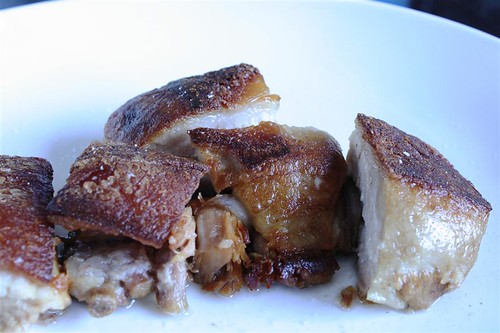 Yummy yummy pork belly ~~!
Yummy yummy pork belly ~~!






